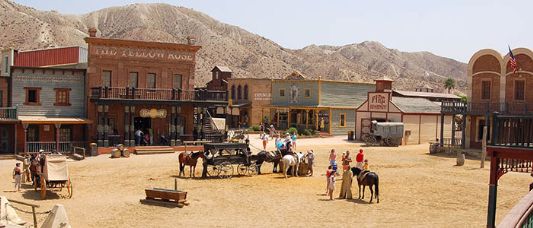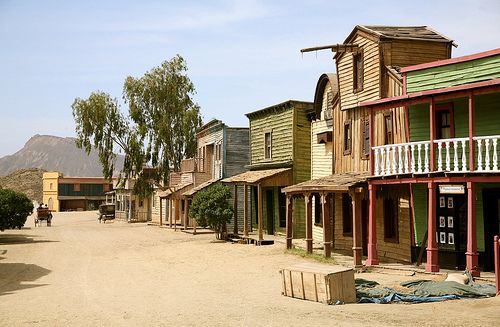Similar to Bardenas Reales which I wrote about last week, is Spain’s other desert “Desierto de Tabernas” en Almeria far more famous than the unknown jewel of Navarre and probably a lot closer to home for many readers and very similar in terms of its weirdly eroded ravines, barren slopes and dry river beds evoking a surreal, almost Martian atmosphere. Although it appears to have a total lack of vegetation there are some fertile areas near the town of Tabernas, which is home to a lot of organic farming mainly due to the range of temperatures which can, through the year range from -3ºC in the winter to 48ºC in the Summer and as it is lodged between the Mountains of Filabres to the north and the Mountains of Alhamilla to the south/ south-east it is isolated from the humid winds of the Mediterranean Sea creating an extremely dry climate not favoured by flies, one of fruit farmers’ most feared pests facilitating the growth of organic fruits, mainly olives.
But what makes this landscape so famous is that Film makers have long been attracted to it due to its similar appearance to the North American Wild West, and so this desert has been the scene of many a “spaghetti” westerns. In fact there is a mini-Hollywood called Oasys now a Theme Park near Tabernas town where many westerns were filmed such as “The Good, The Bad and The Ugly” and “A fistful of Dollars” as well as other films not so “western” such as “Cleopatra” “Lawrence of Arabia” or “Indiana Jones and the last crusade”. Actors such as Clint Eastwood, Brigitte Bardot, Anthony Quinn, Claudia Cardinale, Alain Delon, Sean Connery, Raquel Welch, Orson Welles and many others have all helped make this landscape a Hollywood classic.


Tabernas desert has one of the most interesting landscapes in Europe, since it is clear evidence of the process of natural desertification and erosion. Its unusual features include sheer-sided gullies, carved out by the rare but torrential rains that only fall on a few days each year. Another curious feature is piping, where water permeates through the top of a hill and emerges further down through a hole, the water creating an underground pipe in the process. In certain places there are so many holes that the water has created a Swiss cheese effect.
Eight million years ago in the Miocene period the sea covered the Tabernas desert area, reaching inland as far as the foothills of the Sierra de los Filabres, where today a strip of fossilised coral dunes mark the former coastline. The deposited material consisted of sand and loam and this is what makes up the Tabernas desert today. A million years later the Sierra Alhamilla rose up, cutting off the Tabernas desert area from the ocean and creating an inland sea, where further sand, loam, clay, limestone and gypsum were deposited. At the end of Pliocene Epoch the sea receded, leaving the seabed exposed to erosion.
With its annual rainfall of 240mm concentrated in no more than four days a year, the plants that thrive here are those adapted to semi-arid climates that store water in their leaves or tiny plants that can shelter from the relentless sun near rocks or seek shelter in the shadow of bigger plants. With high levels of salinity in the soil, plants also need to be salt-resistant.
Given the arid conditions, mammals are less common with only 20 species inhabiting the desert the most important being the Algerian hedgehog believe it or not. As a North African species, this is one of the only places where it is found in the Iberian Peninsula. Abundant rabbits, hares and dormice provide plentiful prey for the carnivores and birds of prey in the area.
It may appear as if this harsh landscape is incapable of supporting much in the way of fauna, but along the edges of the seasonal rivers there is a wealth of vertebrates, most notably reptiles and birds. The most commonly seen reptiles are ladder snakes, spiny-footed lizards and Ocellated lizards. Around the more moist areas of the dry riverbeds you can see amphibians such as marsh frogs, natter jack toads and terrapins.
Birds of prey, which are abundant, include Bonellis eagles and Peregrines that use the desert as a hunting ground, visiting from the nearby Sierra de Alhamilla Natural Area. Other raptors are Kestrels and Eagle Owls. There are birds characteristic of rocky slopes like blue rock thrushes, rock sparrows and black Wheat eaters inhabiting the dry river courses of the ramblas.
Tabernas the nearby town that gives its name to the desert has a 14th-century ruined hilltop castle, which used to be the second most important in the province after Almeria's. It served as the refuge of Ferdinand and Isabel during the siege of Almeria. Its 15th-century Mudéjar church is also worth a visit.
Ver mapa más grande